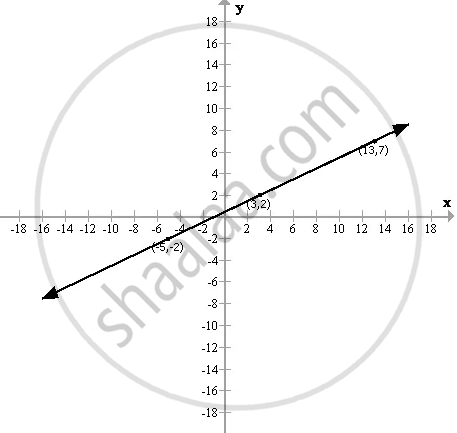Advertisements
Advertisements
Question
Use the table given below to draw the graph.
| X | - 5 | - 1 | 3 | b | 13 |
| Y | - 2 | a | 2 | 5 | 7 |
From your graph, find the values of 'a' and 'b'.
State a linear relationship between the variables x and y.
Solution
The table is:
| X | - 5 | - 1 | 3 | b | 13 |
| Y | - 2 | a | 2 | 5 | 7 |
Plotting the points as shown in the above table, we get the following required graph:

When x = - 1, then y = 0
⇒ a = 0
When y = 5, then x = 9
⇒ b = 9

Let y = px + q ....(1)
be a linear relation between x and y
Substitute x = 9 and y = 5 in the equation (1), we have,
5 = 9p + q ....(2)
Substitute x = - 1 and y = 0 in the equation (1), we have,
0 = - p + q ....(3)
Subtracting (3) from (2), we have,
5 = 10p
⇒ p = `(5)/(10)`
⇒ p = `(1)/(2)`
From (3), we have,
p = q
∴ q = `(1)/(2)`
Thus, the linear relation is
y = px + q
⇒ y = `(1)/(2) x+(1)/(2)`
⇒ y = `(x + 1)/(2)`
APPEARS IN
RELATED QUESTIONS
In countries like USA and Canada, temperature is measured in Fahrenheit, whereas in countries like India, it is measured in Celsius. Here is a linear equation that converts Fahrenheit to Celsius:-
`F=(9/5)C+32`
(i) Draw the graph of the linear equation above using Celsius for x-axis and Fahrenheit for y-axis.
(ii) If the temperature is 30°C, what is the temperature in Fahrenheit?
(iii) If the temperature is 95°F, what is the temperature in Celsius?
(iv) If the temperature is 0°C, what is the temperature in Fahrenheit and if the temperature is 0°F, what is the temperature in Celsius?
(v) Is there a temperature which is numerically the same in both Fahrenheit and Celsius? If yes, find it.
Draw the graph of the equatio ` x / y + y /4 = 1` Also, find the area of the triangle formed by the
line and the co-ordinates axes.
Draw the graph for the equation, given below :
x + 5 = 0
Draw the graph for the equation, given below :
3x + 2y = 6
Draw the graph for the equation, given below :
x - 5y + 4 = 0
Draw the graph for the equation given below; hence find the co-ordinates of the points where the graph is drawn meets the co-ordinates axes:
`(1)/(3) x +(1)/(5) y = 1`.
Draw the graph for each of the following equation: Also, find the coordinates of the points where the graph of the equation meets the coordinate axes:
`(3x + 14)/(2) = (y - 10)/(5)`
Draw the graph of y = x – 4
Draw the graph of the linear equation whose solutions are represented by the points having the sum of the coordinates as 10 units.
The force exerted to pull a cart is directly proportional to the acceleration produced in the body. Express the statement as a linear equation of two variables and draw the graph of the same by taking the constant mass equal to 6 kg. Read from the graph, the force required when the acceleration produced is (i) 5 m/sec2, (ii) 6 m/sec2.
